Field Modeling the Impact of Cracks on the Electroconductivity of Thin-Film Textronic Structures
Abstract
1. Introduction
2. Materials and Methods
2.1. PVD Deposition
2.2. Microscopic Research
3. Analytical Model
3.1. Model Assumptions
- The medium of the area surrounding the defect is a homogeneous, isotropic, and linear conductor.
- The defect area is an ideal dielectric.
- The primary electric field E0, forcing the current flow is constant and homogeneous (by primary field, it means those that would appear in the conductive area under consideration without a defect).
- Field functions do not depend on the coordinate directed perpendicular to the surface of the layer.
- The influence of the edges of the conductive area on the flow field distribution is neglected (i.e., it is assumed that the size of the defect is significantly smaller than the size of the conductive area and is located at a large distance from the edge).
3.2. Formulation of the Issue
3.3. The Solution in the Conductive Area
3.4. Solution in the Defect Area
3.5. Estimation of the Impact of the Defect on the Current Value
3.6. Infinitely Thin Defect
4. Numerical Model
4.1. Formulation of the Issue
4.2. Solution Method
- —coordinates of the collocation point in the local system of the m-th element of discretization (see Figure 7)
- —local coordinates of the ends of the line elements L1−L5
4.3. Sample Results
5. Measurement Verification
6. Estimating the Resistance of a Path with a Defect
7. The Results Comparision
8. Summary and Conclusions
Author Contributions
Funding
Conflicts of Interest
References
- Mubarak, A.M.A.; Hamzah, E.H.E.; Tofr, M.T.M. Review of Physical Vapour Deposition (PVD) Techniques for Hard Coating. J. Mek. 2005, 20, 42–51. [Google Scholar]
- Hamasha, M.M.; Alzoubi, K.; Switzer, J.C., III; Lu, S.; Desu, S.B.; Poliks, M. A study on crack propagation and electrical resistance change of sputtered aluminum thin film on polyethylene terephthalate substrate under stretching. Thin Solid Films 2011, 519, 7918–7924. [Google Scholar] [CrossRef]
- Pardoen, T. Size and rate dependent necking in thin metallic films. J. Mechan. Phys. Solids 2014, 62, 81–98. [Google Scholar] [CrossRef]
- Jia, Z.; Li, T. Necking limit of substrate-supported metal layers under biaxial in-plane loading. Int. J. Plast. 2013, 51, 65–79. [Google Scholar] [CrossRef]
- Pawlak, R.; Tomczyk, M.; Walczak, M. Ablation of selected conducting layers by fiber laser. Proceedings of the 13th International Scientific Conference on Optical Sensors and Electronic Sensors 9291.
- Korzeniewska, E.; Józwik, J.; Zawiślak, R.; Krawczyk, A.; Michałowska, J. Resistance of metallic layers used in textronic systems to mechanical deformation. Prz. Elektrotech. 2017, 93, 111–114. [Google Scholar]
- Tokarska, M.; Frydrysiak, M.; Zieba, J. Electrical properties of flat textile material as inhomegeneous and anisotropic structure. J. Mater. Sci. Mater. Electron. 2013, 24, 5061–5068. [Google Scholar] [CrossRef]
- Hara, K.O.; Yamanaka, J.; Arimoto, K.; Nakagawa, K.; Suemasu, T.; Usami, N. Structural and electrical characterizations of crack-free BaSi2 thin films fabricated by thermal evaporation. Thin Solid Films 2015, 595, 68–72. [Google Scholar] [CrossRef]
- Hoang, P.T.; Salazar, N.; Porkka, T.N.; Joshi, K.; Liu, T.; Dickens, T.J.; Yu, Z. Engineering Crack Formation in Carbon Nanotube-Silver Nanoparticle Composite Films for Sensitive and Durable Piezoresistive Sensors. Nanoscale Res. Lett. 2016, 11, 422. [Google Scholar] [CrossRef]
- Graz, I.M.; Cotton, D.P.J.; Lacour, S.P. Extended cyclic uniaxial loading of stretchable gold thin-films on elastomeric substrates. Appl. Phys. Lett. 2009, 94, 071902. [Google Scholar] [CrossRef]
- Tranter, T.G.; Tam, M.; Gostick, J.T. The Effect of Cracks on the In-plane Electrical Conductivity of PEFC Catalyst Layers. Electroanalysis 2019, 31, 619–623. [Google Scholar] [CrossRef]
- Wang, X.; Zhou, K.; Wu, M.S. Interface cracks with surface elasticity in anisotropic biomaterials. Int. J. Solids Struct. 2015, 59, 110–120. [Google Scholar] [CrossRef]
- Sladek, J.; Sladek, V.; Bishay, P.L.; Garcia-Sanchez, F. Influence of electric conductivity on intensity factors for cracks in functionally graded piezoelectric semiconductors. Int. J. Solids Struct. 2015, 59, 79–89. [Google Scholar] [CrossRef]
- Korzeniewska, E.; Szczesny, A.; Krawczyk, A.; Murawski, P.; Mroz, J. Analysis of the temperature field around the thin electroconductive layers formed on the substrates. In Proceedings of the 18th International Symposium on Electromagnetic Fields in Mechatronics, Electrical and Electronic Engineering, Lodz, Poland, 14–16 September 2017. [Google Scholar]
- Pawłowski, S.; Plewako, J.; Korzeniewska, E. Analysis of flow field distribution in a thin conductive layer with an elliptical defect. Prz. Elektrotech. 2020, 96. [Google Scholar] [CrossRef]
- Maity, S. Optimization of processing parameters of in-situ polymerization of pyrrole on woolen textile to improve its thermal conductivity. Prog. Org. Coat. 2017, 107, 48–53. [Google Scholar] [CrossRef]
- Kim, M.; Kim, S.; Kim, T.; Lee, D.K.; Seo, B.K.; Lim, C.S. Mechanical and thermal properties of epoxy composites containing zirconium oxide impregnated halloysite nanotubes. Coatings 2017, 7, 231. [Google Scholar] [CrossRef]
- Silva, F.J.G.; Casais, R.C.B.; Martinho, R.P.A.; Baptista, P.M. Mechanical and tribological characterization of TiB2 thin films. J. Nanosci. Nanotechnol. 2012, 12, 9187–9194. [Google Scholar] [CrossRef]
- Silva, F.J.G.; Martinho, R.P.; Andrade, M.; Baptista, A.P.M.; Alexandre, R. Improving the wear resistance of moulds for the injection of glass fibre–reinforced plastics using PVD coatings: A comparative study. Coatings 2017, 7, 28. [Google Scholar] [CrossRef]
- Ziaja, J. ZnO thin film deposition with pulsed magnetron sputtering. Prz. Elektrotech. 2007, 83, 235–239. [Google Scholar]
- Pawlak, R.; Korzeniewska, E.; Koneczny, C.; Hałgas, B. Properties of conductive structures produced by PVD method on a textile composites by using the PVD method for textronic applications. Autex Res. J. 2017, 17, 229–237. [Google Scholar] [CrossRef]
- Skordaris, G.; Bouzakis, K.; Kotsanis, T.; Charalampous, P.; Bouzakis, E.; Breidenstein, B.; Bergmann, B.; Denkena, B. Effect of PVD film’s residual stresses on their mechanical properties, brittleness, adhesion and cutting performance of coated tools. CIRP J. Manuf. Sci. Technol. 2017, 18, 145–151. [Google Scholar] [CrossRef]
- Skordaris, G.; Bouzakis, K.; Kotsanis, T.; Charalampous, P.; Bouzakis, E.; Lemmer, O.; Bolz, S. Film thickness effect on mechanical properties and milling performance of nano-structured multilayer PVD coated tools. Surf. Coat. Technol. 2016, 307, 452–460. [Google Scholar] [CrossRef]
- Baptista, A.; Silva, F.; Porteiro, J.; Míguez, J.; Pinto, G. Sputtering Physical Vapour Deposition (PVD) Coatings: A Critical Review on Process Improvement and Market Trend Demands. Coating 2018, 8, 402. [Google Scholar] [CrossRef]
- Korzeniewska, E.; Walczak, M.; Rymaszewski, J. Elements of elastic electronics created on textile substrate. MIXDES 2017, 8005250, 447–450. [Google Scholar]
- Gniotek, K.; Krucinska, I. The basic problems of textronics. Fibres Text. East. Eur. 2004, 12, 13–16. [Google Scholar]
- Rymarczyk, T.; Nita, P.; Vejar, A.; Wos, M.; Stefaniak, B.; Adamkiewicz, P. Wareable mobile measuring device based on electrical tomography. Prz. Elektrotech. 2019, 95, 211–214. [Google Scholar] [CrossRef]
- Rymarczyk, T.; Klosowski, G.; Tchorzewski, P.; Cieplak, T.; Kozlowski, E. Area monitoring using the ERT method with multisensor electrodes. Prz. Elektrotech. 2019, 95, 153–156. [Google Scholar] [CrossRef]
- Jakubas, A.; Lada-Tondyra, E.; Nowak, M. Textile sensors used in smart clothing to monitor the vital functions of young children. In Proceedings of the 2017 Progress in Applied Electrical Engineering (PAEE), Koscielisko, Poland, 25–30 June 2017. [Google Scholar]
- Korn, G.A.; Korn, T.M. Mathematical Handbook for Scientists and Engineers; McGraw-Hill Book Company: New York, NY, USA, 1968. [Google Scholar]
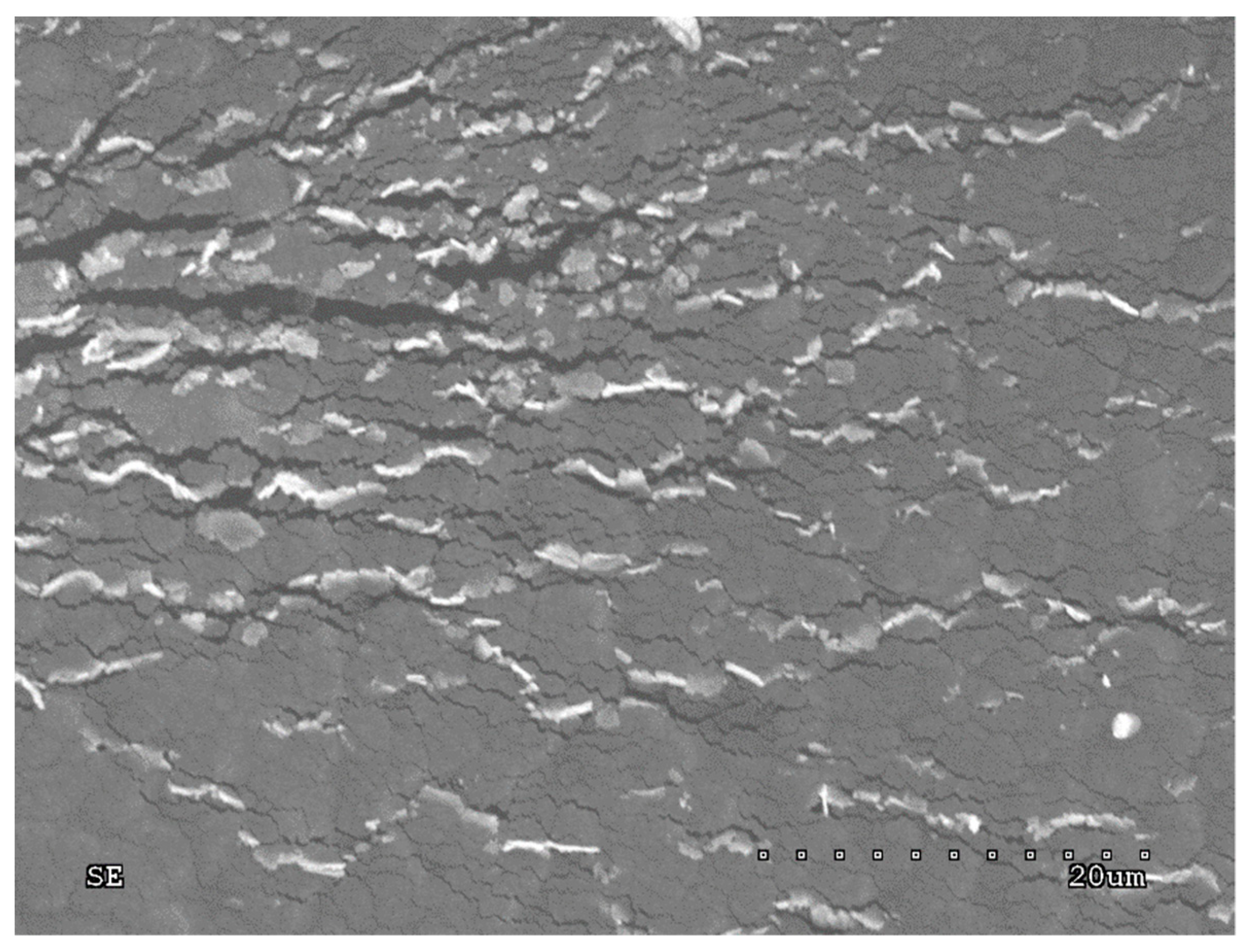
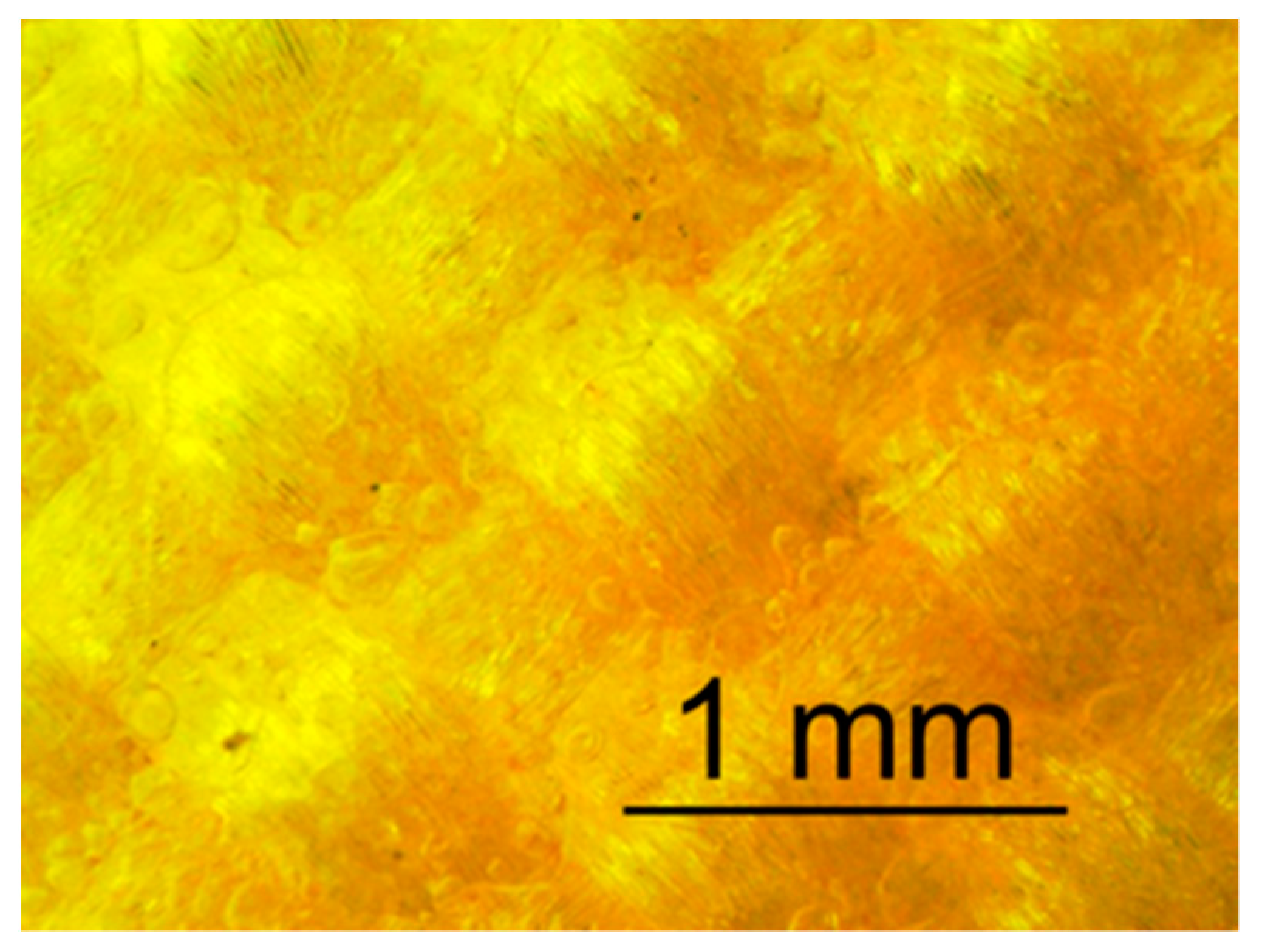
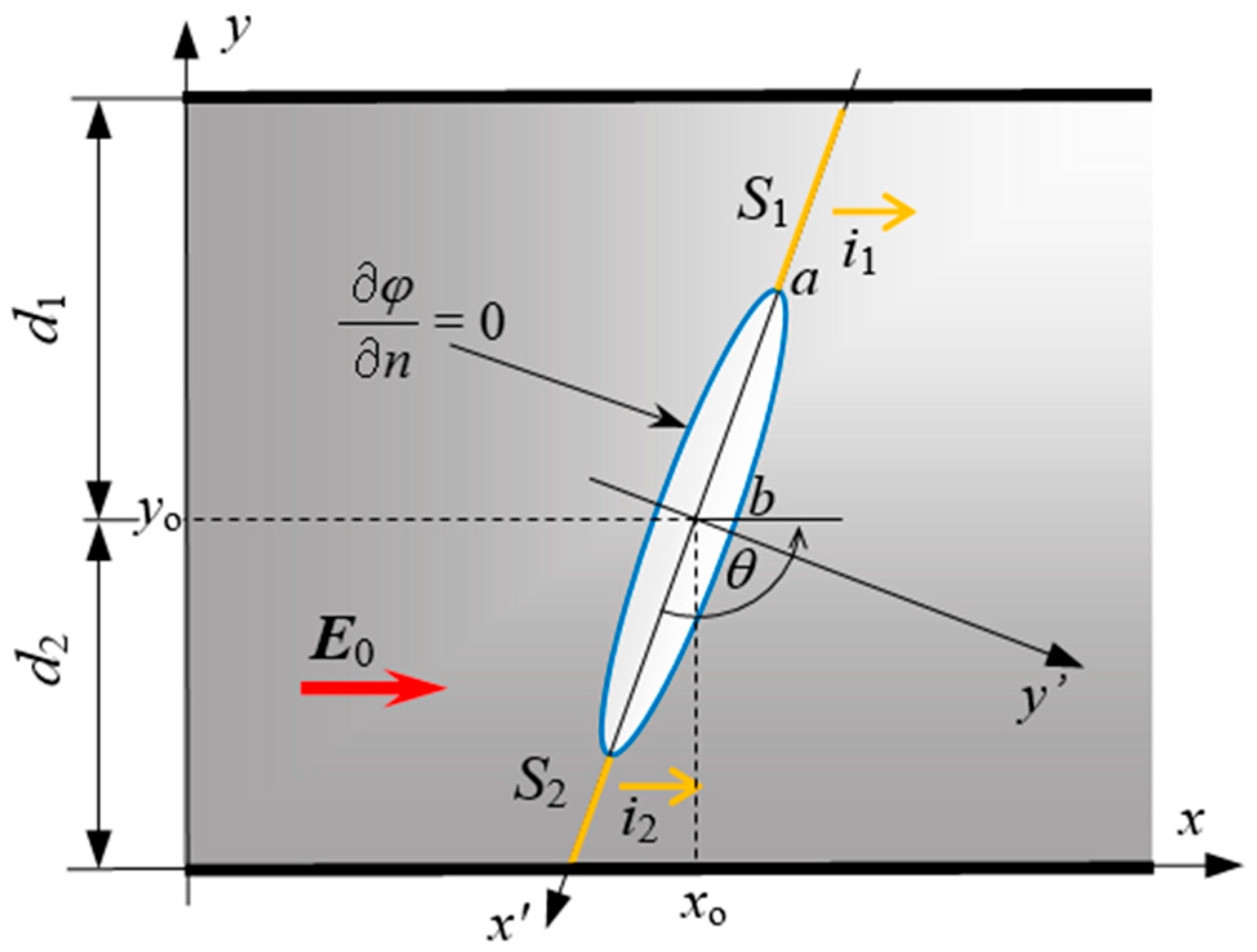
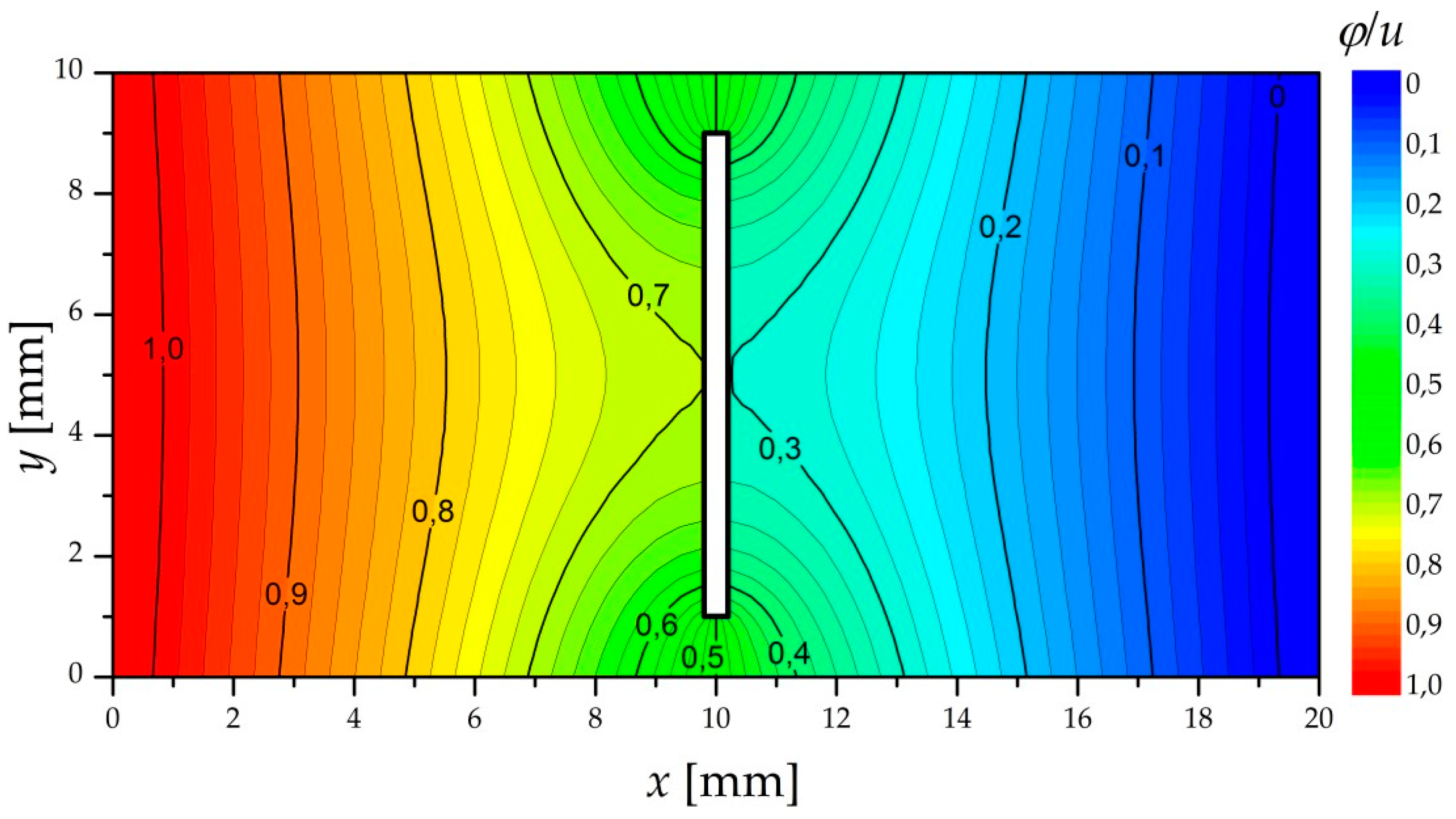

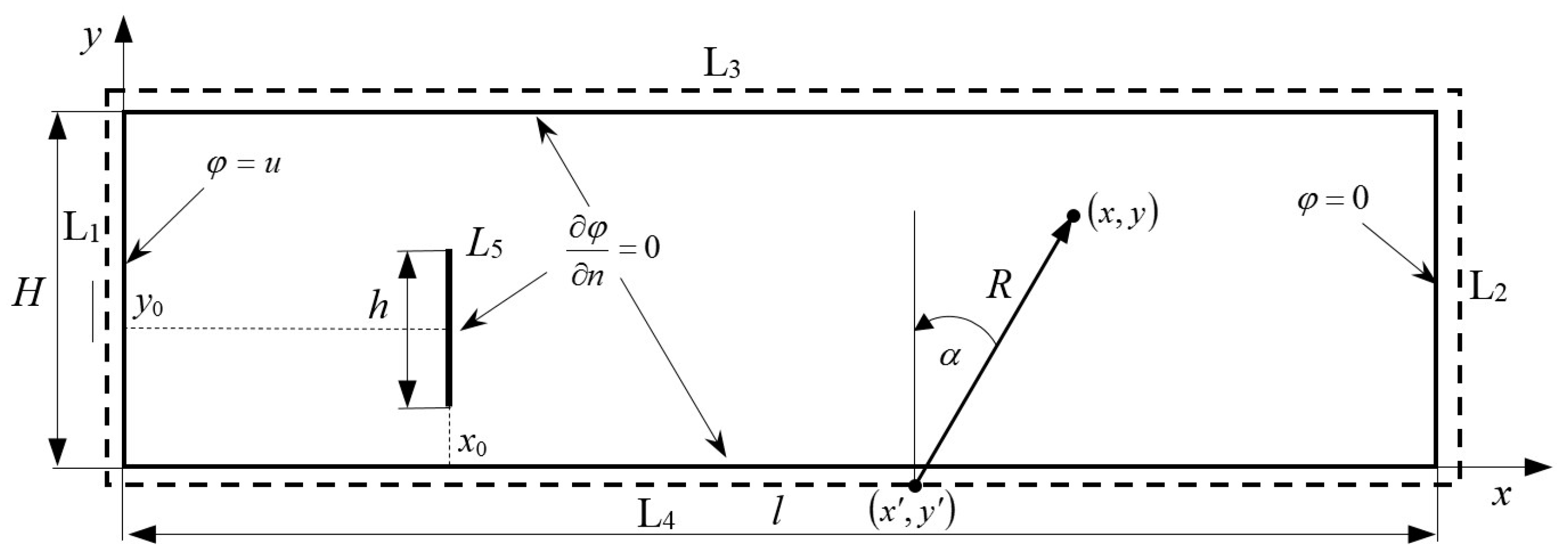

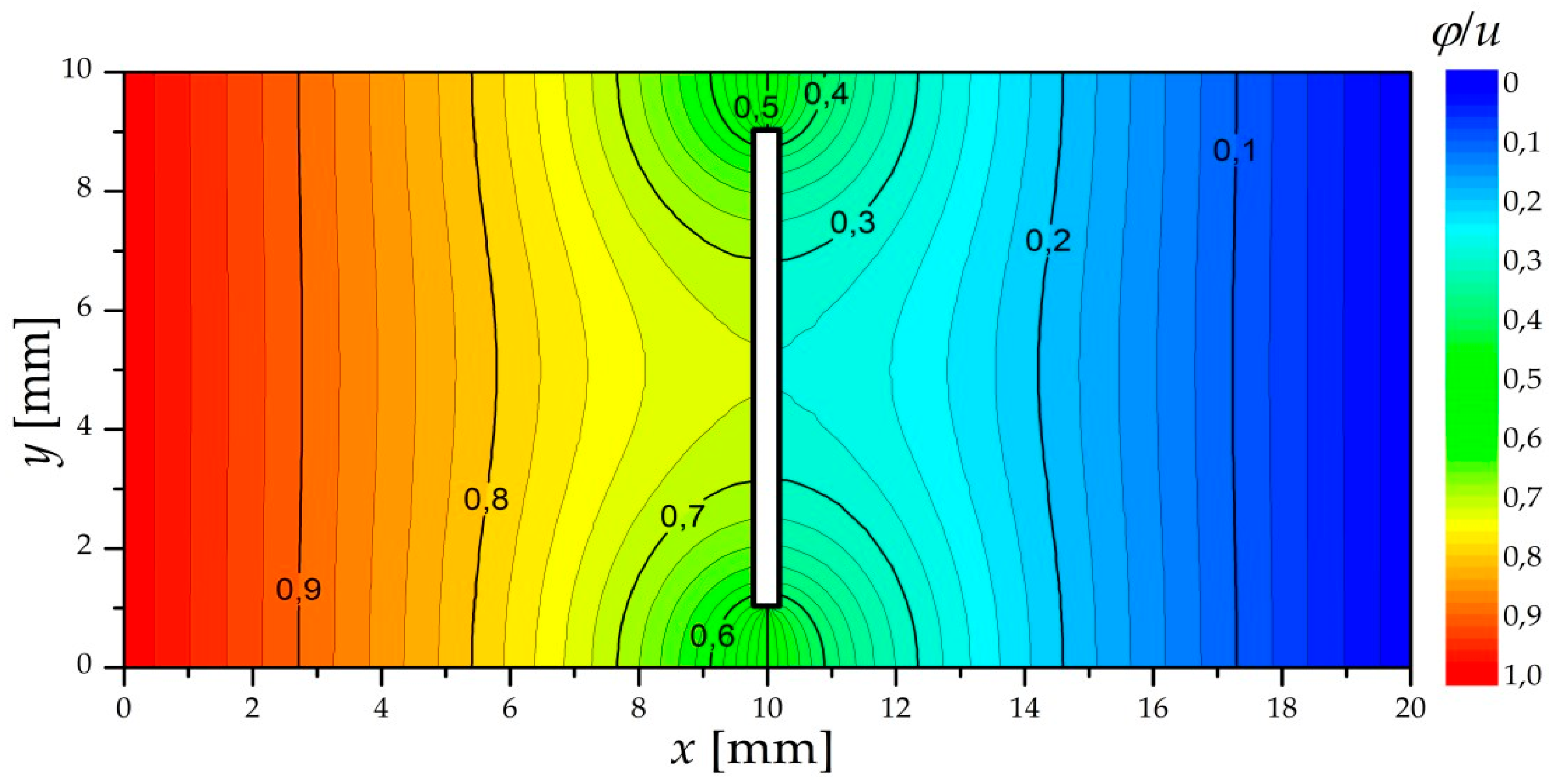

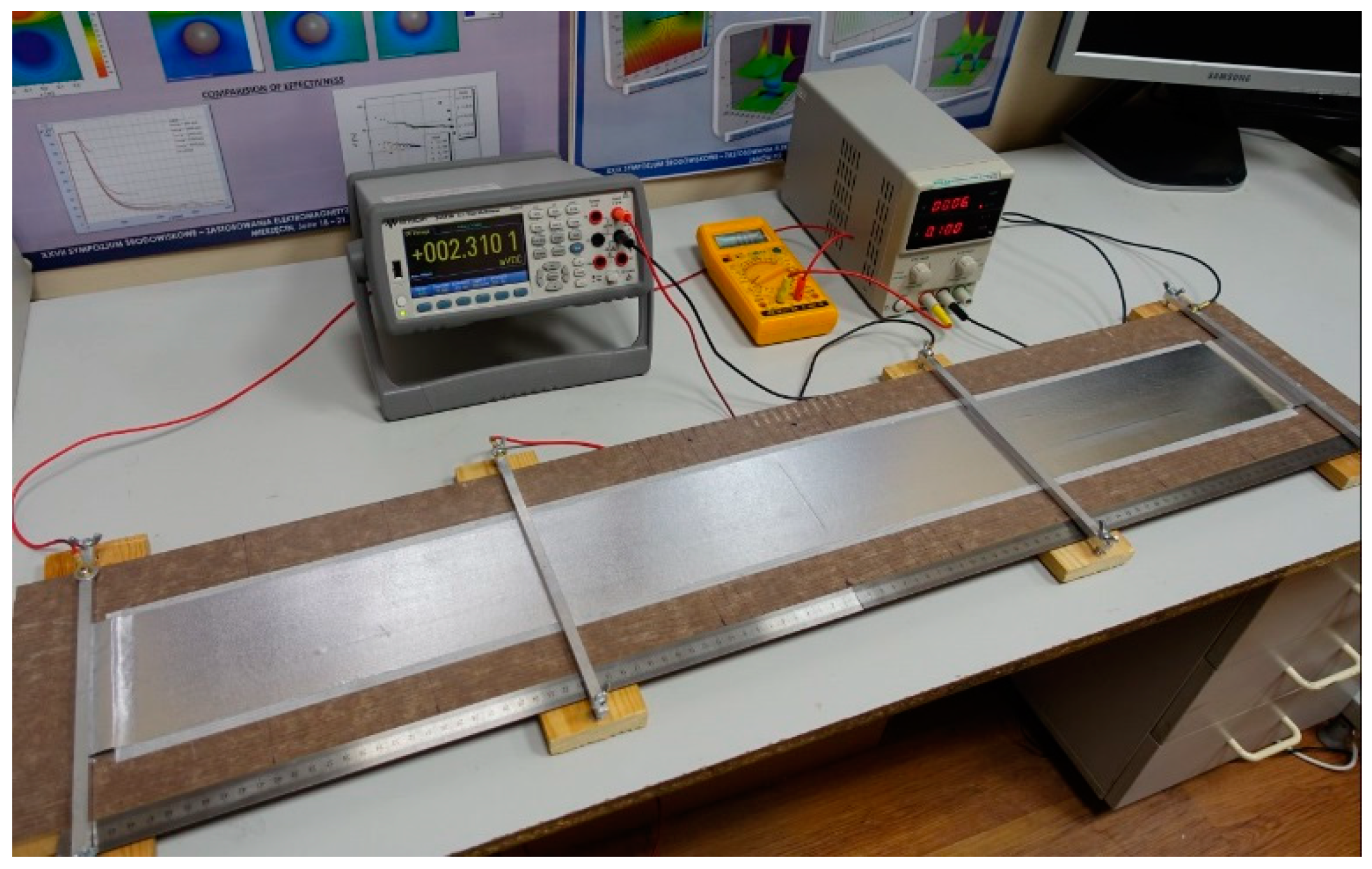
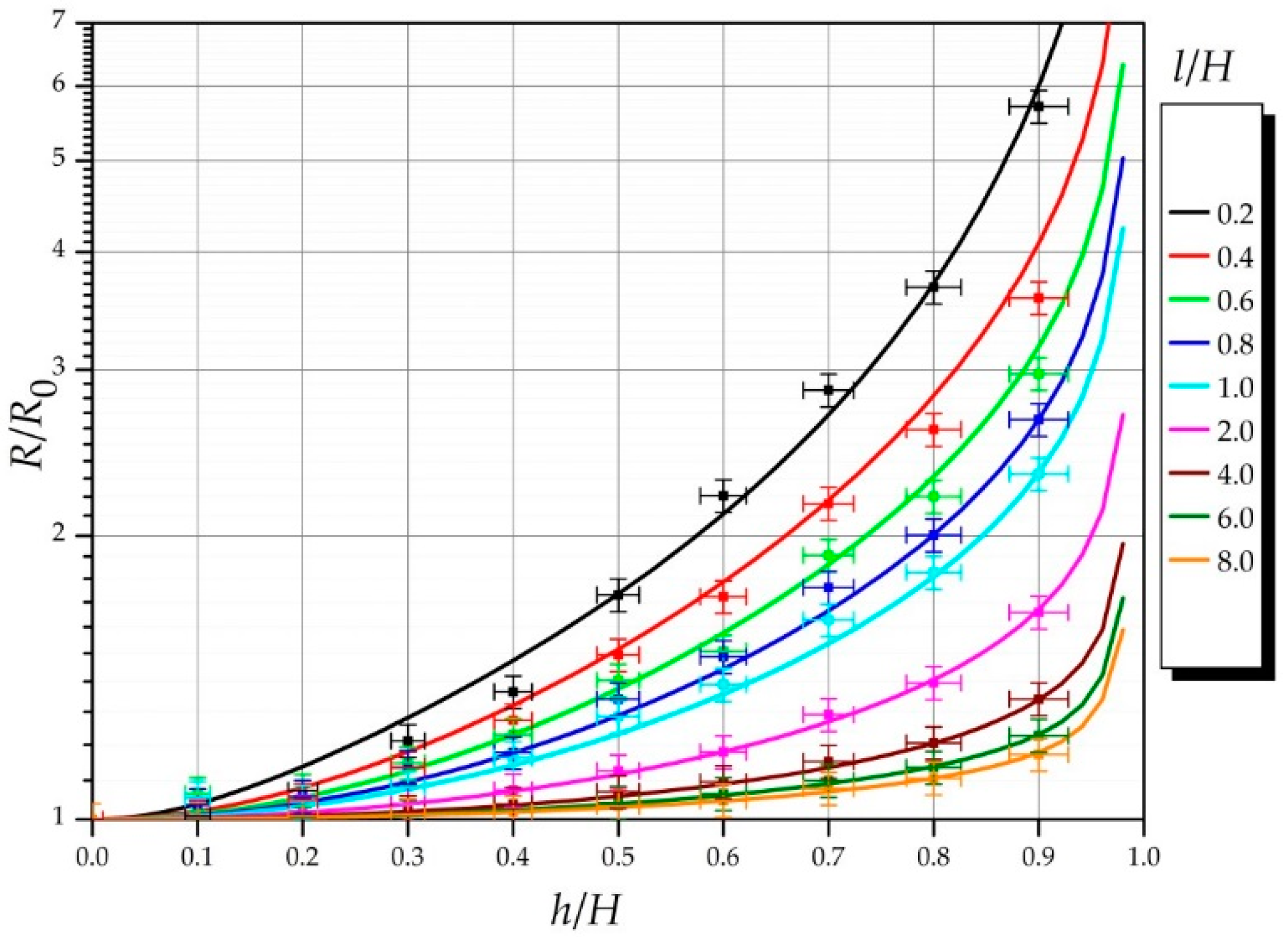
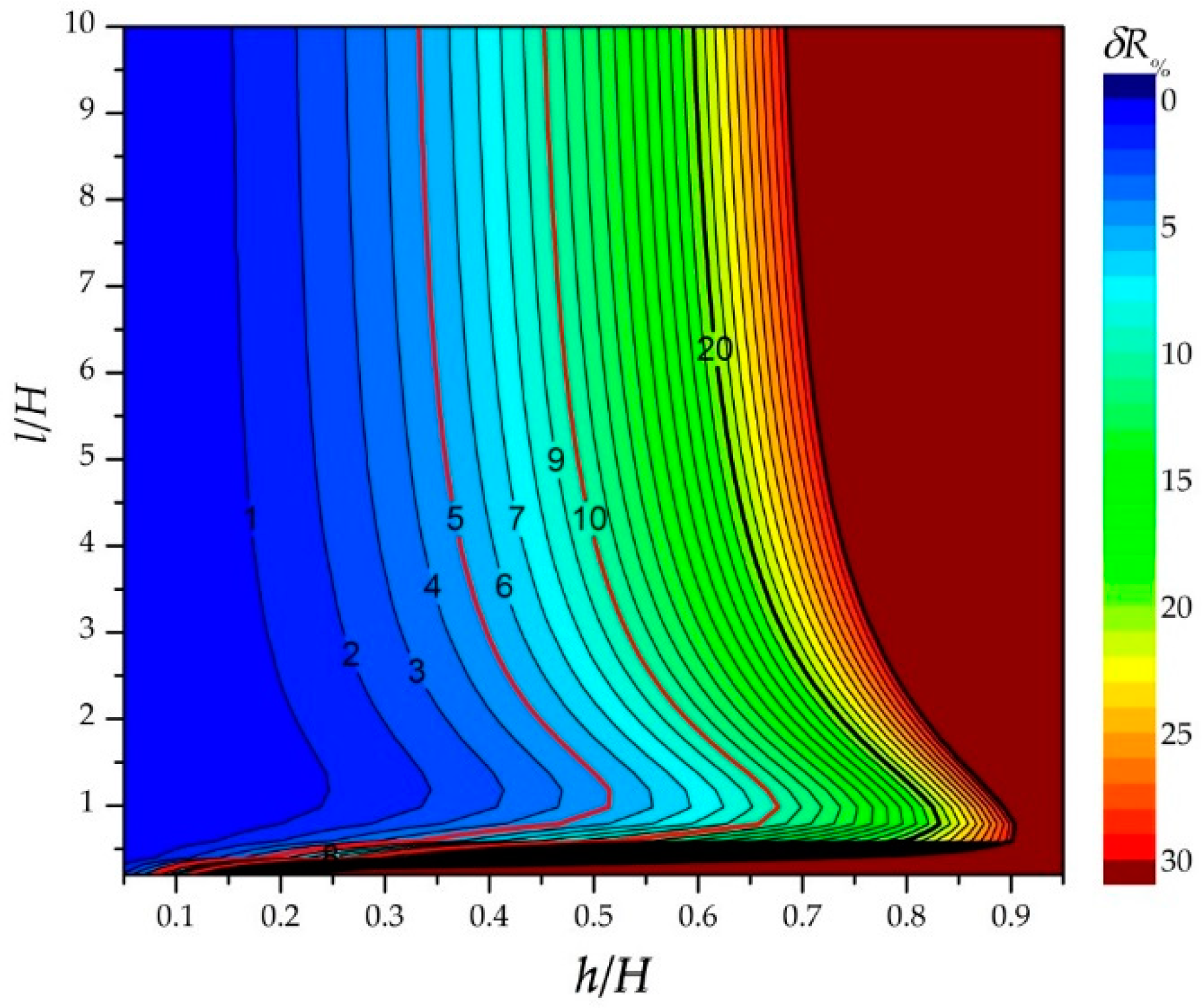
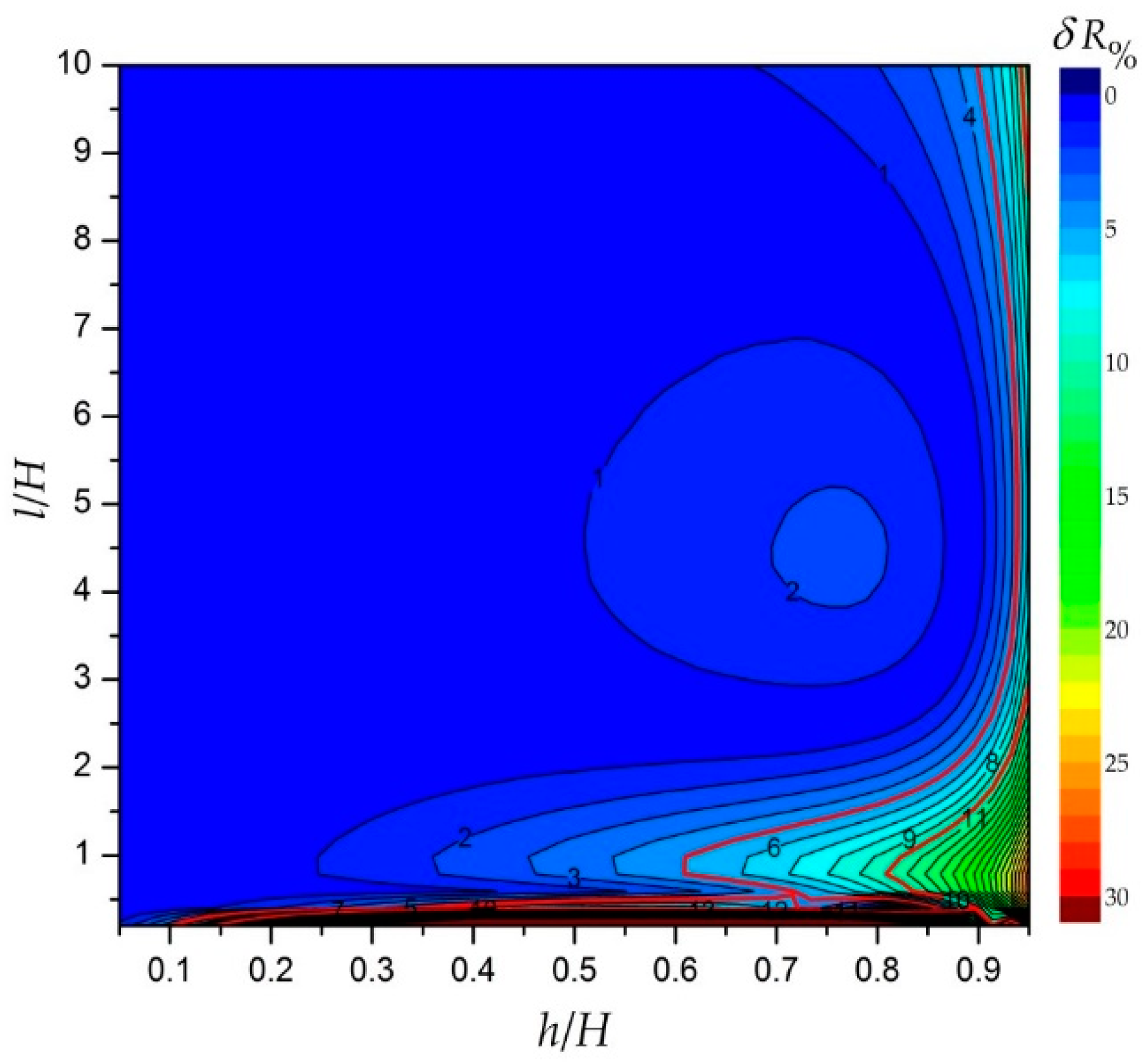
| Relative Length of the Defect h/H | Analytical Calculations According to the Formula (36) | Analytical Calculations According to the Formula (36) with Correction Formula (52) | Numerical Calculations | Measurements |
|---|---|---|---|---|
| 0.1 | 1.005 | 1.002 | 1.002 | 1.005 ± 0.020 |
| 0.2 | 1.022 | 1.010 | 1.008 | 1.012 ± 0.020 |
| 0.3 | 1.051 | 1.022 | 1.019 | 1.019 ± 0.020 |
| 0.4 | 1.097 | 1.040 | 1.036 | 1.039 ± 0.021 |
| 0.5 | 1.164 | 1.067 | 1.059 | 1.070 ± 0.021 |
| 0.6 | 1.264 | 1.104 | 1.090 | 1.097 ± 0.022 |
| 0.7 | 1.422 | 1.154 | 1.135 | 1.152 ± 0.023 |
| 0.8 | 1.700 | 1.224 | 1.205 | 1.205 ± 0.024 |
| 0.9 | 2.352 | 1.321 | 1.339 | 1.341 ± 0.026 |
© 2020 by the authors. Licensee MDPI, Basel, Switzerland. This article is an open access article distributed under the terms and conditions of the Creative Commons Attribution (CC BY) license (http://creativecommons.org/licenses/by/4.0/).
Share and Cite
Pawłowski, S.; Plewako, J.; Korzeniewska, E. Field Modeling the Impact of Cracks on the Electroconductivity of Thin-Film Textronic Structures. Electronics 2020, 9, 402. https://doi.org/10.3390/electronics9030402
Pawłowski S, Plewako J, Korzeniewska E. Field Modeling the Impact of Cracks on the Electroconductivity of Thin-Film Textronic Structures. Electronics. 2020; 9(3):402. https://doi.org/10.3390/electronics9030402
Chicago/Turabian StylePawłowski, Stanisław, Jolanta Plewako, and Ewa Korzeniewska. 2020. "Field Modeling the Impact of Cracks on the Electroconductivity of Thin-Film Textronic Structures" Electronics 9, no. 3: 402. https://doi.org/10.3390/electronics9030402
APA StylePawłowski, S., Plewako, J., & Korzeniewska, E. (2020). Field Modeling the Impact of Cracks on the Electroconductivity of Thin-Film Textronic Structures. Electronics, 9(3), 402. https://doi.org/10.3390/electronics9030402






